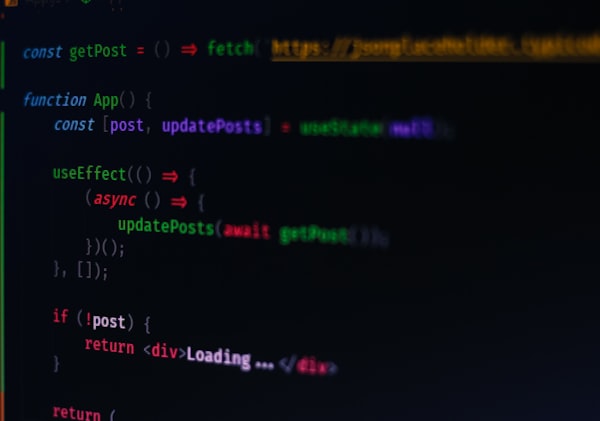Understanding the Basics of JavaScript
First things first, it's time to make the acquaintance of our good friend, JavaScript. Some people mistake it for Java, but trust me, they're as different as chalk and cheese, or if you're into JavaScript...as different as let and const.
In the simplest terms, JavaScript is a programming language that adds life to your web page, kind of like coffee adds life to your Mondays. Without it, your web pages would be static and dull, like a party without music (Yes, HTML and CSS, I'm looking at you!).
JavaScript can update and change both HTML and CSS, control multimedia, and is as ubiquitous in the internet world as cat videos. The cherry on top? It's also lightweight and speedy, like your dream bicycle but with superpowers.
To really get a grasp of JavaScript, you need to start by understanding its key concepts such as variables, functions, loops, and events. Imagine a town where variables are like houses, each storing different kinds of data. Functions, on the other hand, are the local pizza delivery guys, taking inputs, processing them, and returning a result. Loops? They're like the town's roundabouts, circling back until a certain condition is met. As for events, they're the exciting stuff happening in the town, like the click of a mouse or a button press, that trigger JavaScript to spring into action.
For a more in-depth understanding of these concepts, MDN's JavaScript guide is a fantastic resource to delve into. Now that you've got the basics down, let's get ready to dive into the delightful world of JavaScript design patterns. It's going to be a heck of a ride!
What are Design Patterns: A Primer
Next on our agenda: understanding design patterns. No, this isn't a crochet or knitting class. In the world of coding, design patterns aren't about making your website look pretty with cute icons and fancy fonts, but rather, they're about keeping your code clean, efficient, and well, patterned.
Design patterns are like pre-made blueprints that help solve common design problems in programming. It's kind of like the IKEA flat-pack furniture of the coding world. All the parts are neatly packaged, with clear instructions to follow, leading to less stress and more success. Except with design patterns, there's no missing screws or confusing diagrams to deal with.
One of the coolest things about design patterns is they're reusable. Yup, you heard that right! They can be adapted to suit individual needs - more like the superheroes of programming, always ready to save the day, regardless of the project.
There are three main types of design patterns - Creational, Structural, and Behavioural. Not to be confused with cereal, structure, and behaviour, although breakfast and good manners are important too! Creational patterns deal with object creation mechanisms, Structural patterns ensure the components fit together like a jigsaw puzzle, and Behavioural patterns handle communication between objects.
By understanding and applying these patterns, you'll be able to produce more efficient, clear, and concise code. More importantly, you'll save yourself from hours of coding conundrums, freeing up time for life's other delights like, say, enjoying a donut or binging your favourite show.
Ready for the deep dive? Strap on your diving gear and let's explore some of the most common JavaScript design patterns in the next section. Oh, and don't forget your sense of humour. We're going to need it!
Importance of Design Patterns in JavaScript
Now that we've navigated the 'what' of design patterns, it's time to take on the 'why'. Why, you may wonder, should we care about these patterns in JavaScript or in any other programming language? Well, let me tell you, it's more important than remembering your anniversary (though you should absolutely remember that too).
Design patterns are crucial in JavaScript for several reasons:
Firstly, they help to keep our code DRY (Don't Repeat Yourself). Let's face it, repetition is as fun as watching paint dry. Design patterns come in like your favourite playlist - adding variety and rhythm to your coding routine.
Secondly, design patterns make our code more maintainable. Imagine trying to find a specific seashell on a beach. Sounds tricky, right? Now, imagine if those shells were arranged according to their size, color, and shape. So much easier! That's exactly what design patterns do - they organise code so it's easier to read, modify, and maintain.
Additionally, design patterns ensure our code is efficient and scalable. Picture building a skyscraper with Lego blocks. If you have a solid plan (aka design pattern), you can build higher and faster without worrying about the whole structure collapsing.
Lastly, these patterns promote teamwork. With design patterns, you're using a language that other developers understand. It's like speaking Esperanto in the world of code. You're instantly part of an international community that speaks and understands the same lingo.
So, dear readers, using design patterns in JavaScript is like using a GPS during a road trip. It makes the journey easier, faster, and more enjoyable. Buckle up because, in the next section, we're about to take a closer look at some of the most popular design patterns in JavaScript! Get ready to pattern up, folks!
Exploring Common JavaScript Design Patterns
Alrighty then, now that we've covered the 'what' and 'why' of design patterns, let's shift gears and check out the 'which'—specifically, which design patterns are the talk of the town in JavaScript city.
First off, let's chat about the Singleton Pattern. This nifty pattern is like the Only Child of the JavaScript family, ensuring that a class has just one instance, and providing a global point of access to it. Handy, isn't it?
Next up, we have the Observer Pattern, the ultimate town gossip of JavaScript, keeping everyone in the loop. It allows an object (known as the subject) to notify other objects (the observers) when its state changes.
Rolling on, we encounter the Module Pattern. Just like that drawer in your house where you store everything that doesn't fit elsewhere (we all have one, don't pretend!), the Module Pattern keeps your code organised by encapsulating information into distinct modules.
Our next stop on this pattern journey is the Prototype Pattern. If JavaScript was a car, the Prototype Pattern would be the engine. It forms the basis of JavaScript's object-creation model, promoting code reusability and efficiency.
But our tour doesn't end here, no siree! We've got more design patterns waiting for you in the coming sections. So, grab your explorer hat and your adventurous spirit, and let's continue this riveting journey through the land of JavaScript design patterns. Onwards, coding comrades!
Singleton Pattern: Its Role and Application in JavaScript
Time for our first in-depth rendezvous with a design pattern. Meet the Singleton Pattern, a pattern that insists on being unique, just like that one friend who insists on ordering a pumpkin spice latte in the middle of summer.
The Singleton Pattern is like a stubborn goat—there can only be one instance of a class, and it makes sure of it. It's the gatekeeper, ensuring only one object gets created, and provides a global point of access to it. It's like the Queen's Guard of JavaScript classes—always vigilant and only one on duty.
But why is this useful? Think of it like a universal remote control for your smart home. Instead of having different controllers for your TV, lights, music system, wouldn't you prefer to have just one? That's what Singleton does—it becomes the one master object that controls various parts of your application, reducing confusion and enhancing efficiency.
Singleton Pattern comes into play in scenarios like managing app-wide settings, controlling access to shared resources, or when logging or caching needs to be handled. In all these cases, having a single instance prevents us from creating additional, unnecessary instances, saving resources and keeping our code efficient.
Sounds cool, right? Singleton Pattern isn't just about being unique—it's about being a one-stop solution, a one-man army, a one...you get the idea. If JavaScript were a band, Singleton would definitely be the lead singer—singular, powerful, and unmissable.
Just remember: with great power comes great responsibility. Singleton can be a hero or a villain depending on how you use it. So wield this power wisely!
Let's continue our journey and explore another superstar of JavaScript design patterns in the next section. Stay tuned!
Observer Pattern: An Essential Tool for JavaScript Developers
Allow me to introduce you to the Observer Pattern, the Chatty Cathy of JavaScript. Always in the know, always keeping others informed, the Observer Pattern is essentially your coding version of a community gossip or your daily news app, ensuring you never miss out on the big updates.
This pattern consists of a subject and an array of observers. The subject is like the party host - it has methods to add or remove observers, kind of like sending out party invites or crossing people off the guest list. Each observer, like a party guest eagerly waiting for the next round of appetizers, waits for an update from the subject, after which it can react accordingly.
Where might we use this? Picture a notification system, like the one in your favourite online store, that alerts you when that snazzy pair of shoes you've been eyeing finally goes on sale. The moment the price drops (subject), all those waiting for this news (observers) are notified.
Or consider an event handling system in a UI library, where, for instance, a button press (subject) can trigger a series of actions (observers) like playing a sound, displaying a message, or popping a confetti explosion (if you're into that sort of thing).
The Observer Pattern is quite the social butterfly of design patterns, promoting a strong level of indirection. This means that the subject doesn't need to know anything about the observers, and vice versa. They're like friendly neighbours, respecting each other's space but always ready to chat over the fence.
In the wild jungle of coding, the Observer Pattern is your friendly parrot, always squawking loudly to alert you of changes. So, prepare to be kept in the loop with this informative design pattern. Now, let's soar ahead to our next JavaScript design pattern, shall we?
Module Pattern in JavaScript: For a Better Code Organization
Next up on our JavaScript design pattern catwalk is the stylish and sophisticated Module Pattern. Imagine if Marie Kondo, the organisation guru, decided to take up programming—she'd definitely be all about the Module Pattern. It's all about keeping things neat, tidy, and joy-sparking.
The Module Pattern is the Leonardo da Vinci of JavaScript—it believes in encapsulation, meaning it helps to keep your functions and variables private, revealing only what is necessary. Think of it as your own personal dressing room in the chaotic shopping mall of code. Only you decide what's on display!
The power of the Module Pattern is in providing structure and helping maintain order in your code. It’s like a well-organised toolbox where everything has its place and you know exactly where to find what you need. No more fumbling around searching for that one function amidst a jumbled spaghetti mess of code.
One key aspect of the Module Pattern is that it's based on object literals and immediately-invoked function expressions (IIFEs). Imagine a firework that explodes immediately upon launch. That's what IIFEs are - functions that run as soon as they're defined. Boom!
In JavaScript, the Module Pattern is a lifesaver when it comes to organising code, managing global variables, and providing encapsulation. It's like the traffic controller of your JavaScript city, making sure everything runs smoothly and efficiently.
So, if you value cleanliness, organisation, and a dash of privacy, the Module Pattern should be your go-to. And who knows? It may just spark joy in your coding journey. Stay tuned as we reveal the next top model in our JavaScript design pattern fashion show!
Prototype Pattern: Boosting Performance in JavaScript
And now, allow me to introduce the power player of our design pattern lineup: the Prototype Pattern. If JavaScript was an action movie, the Prototype Pattern would surely be the protagonist—fast, efficient, and full of surprises.
In JavaScript, objects are like magical bags that contain not only properties but also their own prototypes, which are objects themselves! Sounds a bit like a rabbit hole, doesn't it? But don't fret, it's not as confusing as it sounds.
The Prototype Pattern leverages this unique capability of JavaScript objects to boost performance and save memory. Instead of creating multiple copies of methods for each instance of an object, the Prototype Pattern attaches these methods to the prototype of the object. Now, all instances can simply refer to the prototype for these methods. It's like sharing a Netflix subscription with your friends—we all get to enjoy the latest shows, but we only need one subscription.
This pattern can prove especially useful when you're creating numerous instances of an object, like minions from a minion factory. With the Prototype Pattern, these minions can share behaviours defined in the prototype, which keeps our code efficient and our memory footprint low.
However, just like forgetting to put the toilet seat down can cause some chaos at home, modifying objects in JavaScript without considering their prototypes can lead to unexpected results. So remember, handle with care!
The Prototype Pattern is undoubtedly a potent tool for JavaScript developers, driving performance, and promoting code reuse. It's the high-octane fuel that keeps our JavaScript engine running smoothly. Buckle up and enjoy the ride as we zoom ahead to explore more JavaScript design patterns in the upcoming sections!
How Design Patterns Improve Scalability and Efficiency
At this point in our journey, we've dipped our toes in a few design patterns. Now, it's time to step back and appreciate the larger picture. The Mona Lisa smile of our article, if you will: How do design patterns contribute to scalability and efficiency in your code?
Think of design patterns as your trusty workout regimen. Just as following a routine helps build your strength and endurance over time, using design patterns can enhance the power and performance of your JavaScript code.
Let's talk about scalability first. In this fast-paced digital world, your application needs to handle growth smoothly, be it a surge in user traffic, a deluge of data, or expanding to new features. And here's where design patterns come in, like a skilled yoga instructor, ensuring your code remains flexible and adaptable to change. They enable you to add new features without disrupting the existing system, thus promoting scalability.
On to efficiency, a key performance indicator for any application. Design patterns are like those timesaving hacks that keep your code lean and mean. They can prevent redundant code, facilitate code reuse, and optimise execution—like using a shortcut on your daily commute or making your coffee the night before.
For instance, the Prototype Pattern allows objects to share behaviours, saving memory. Singleton Pattern prevents unnecessary instances, conserving resources. Observer Pattern optimises event handling, ensuring efficient updates. In other words, they help you get more bang for your buck!
In conclusion, design patterns in JavaScript are the secret sauce that can make your code scalable and efficient. They are like the superheroes of your codebase, always there to save the day, be it handling growth or boosting performance. So, why not leverage their power in your next JavaScript project?
Best Practices for Implementing Design Patterns in JavaScript
Welcome, my fellow design pattern enthusiasts, to the life of the party—the "Best Practices" section. This is where we get into the nitty-gritty of how to really strut your stuff when it comes to implementing design patterns in JavaScript.
- Understand Before You Implement: Design patterns are not one-size-fits-all solutions that you can slap onto your code like a band-aid on a boo-boo. They're more like the right set of tools for a specific job. So, understand the problem first, then select the appropriate pattern. It's a bit like dating—you gotta get to know them before you commit!
- Keep It Simple, Smarty (KISS): Just because you've learned some fancy new design patterns doesn't mean you need to use them everywhere. Remember the KISS principle. If your code starts looking like a Jackson Pollock painting, you're probably overdoing it. Use patterns where they add value and keep things simple where they don't.
- Don’t Reinvent the Wheel: Design patterns are tried-and-tested solutions to common problems. So, no need to come up with new solutions when one already exists. It's like ordering pizza instead of trying to make one from scratch—saves time and probably tastes better too.
- Consistency Is Key: Once you've chosen to use a design pattern, stick to it consistently across your codebase. Inconsistency can confuse other developers (and probably future you). It's like having one foot in two boats—sooner or later, you're going to end up in the water.
- Document, Document, Document: Make sure to document where and why you've used a design pattern. It's like leaving a trail of breadcrumbs for other developers to follow. And trust me, they'll thank you for it.
- Stay Current: JavaScript and its associated libraries and frameworks evolve faster than fashion trends. So, make sure to stay up-to-date and understand how these changes affect design patterns. It's like keeping up with the latest dance moves—you don't want to be caught flossing when everyone else is doing the moonwalk!
By following these best practices, you'll be implementing design patterns like a pro in no time.








